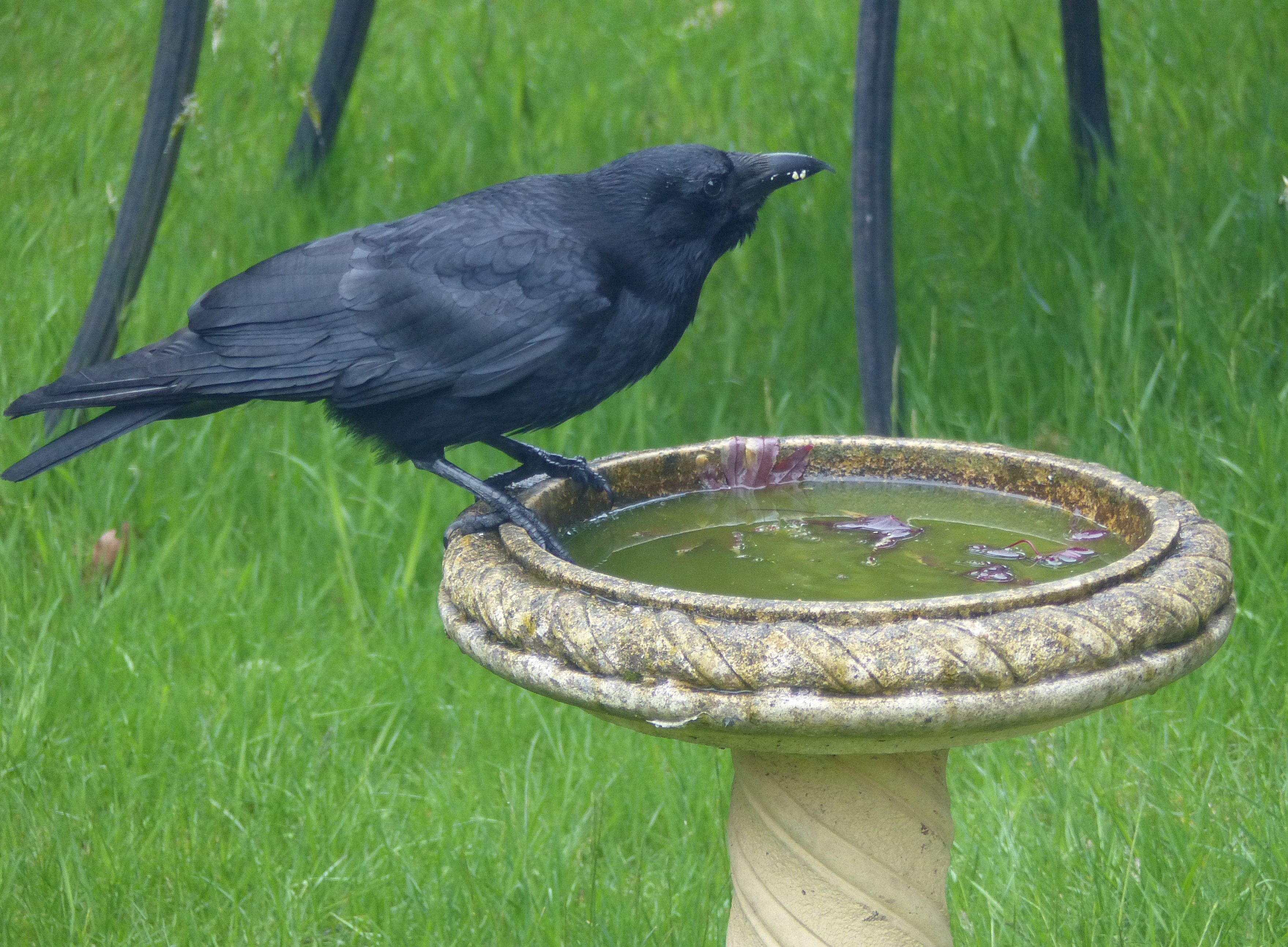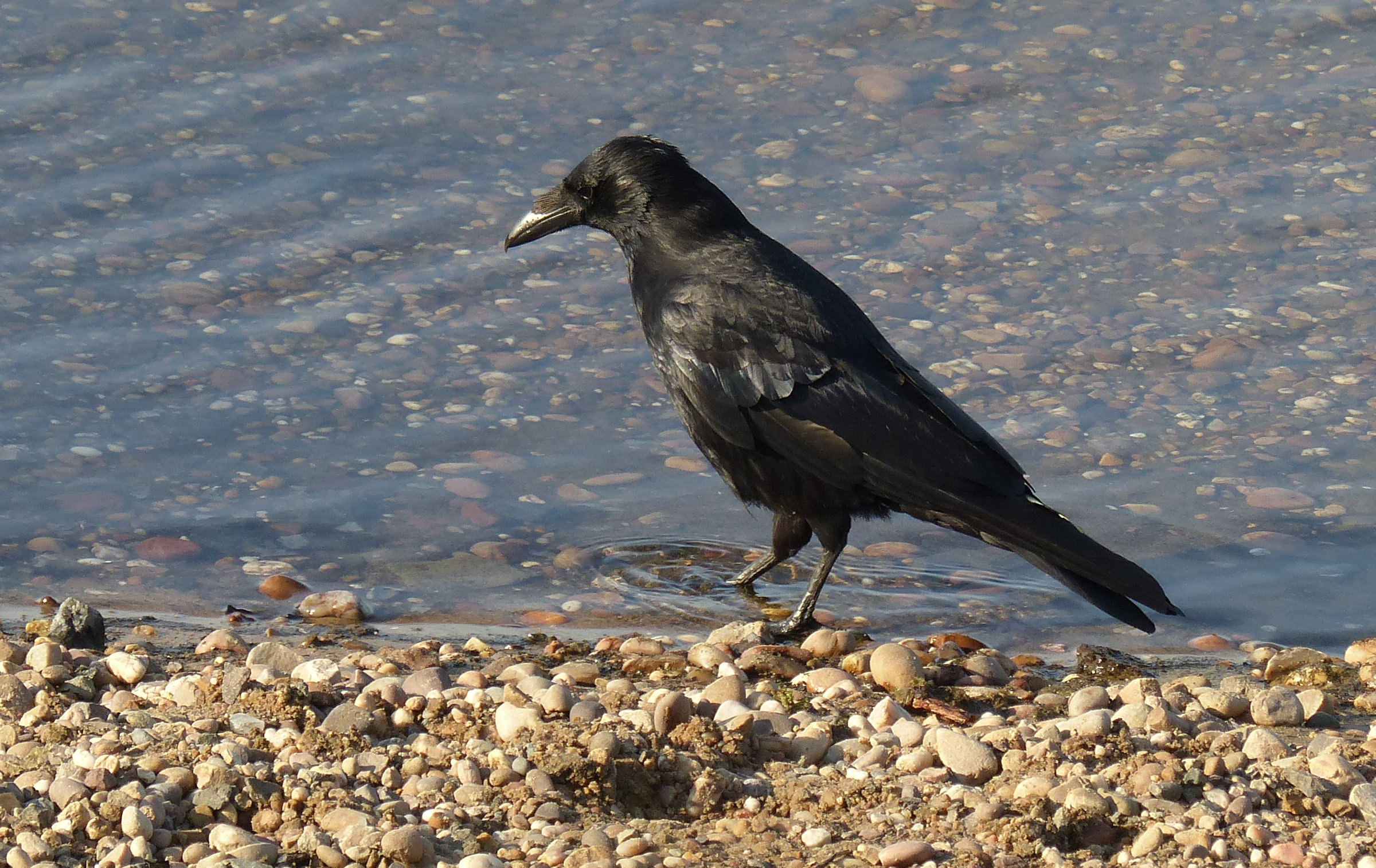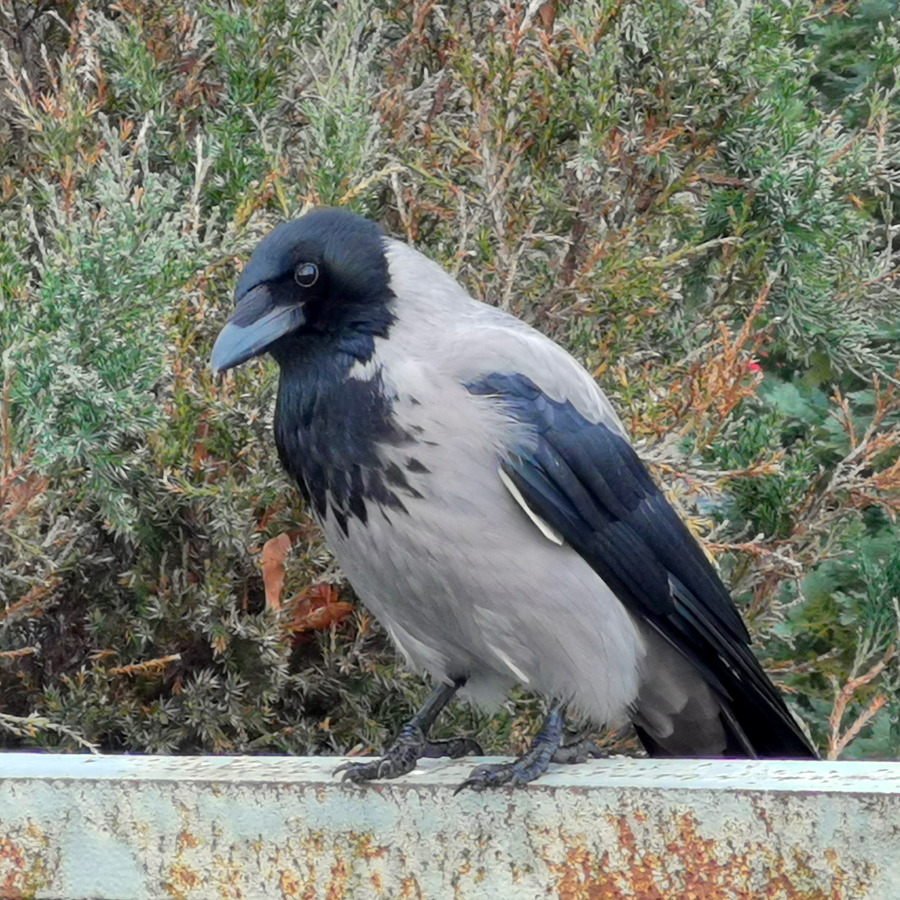Garden Wildlife
Garden Wildlife


What do they look like?
Most people have a pretty good idea of what carrion crow looks like – any large completely black bird is likely to be given that name. However you need to think about rook in rural areas, or raven in the north and west - and more often now in Southern Britain. At 46 cm carrion crows are half as big again as Jackdaws and lack the grey hood.
The carrion crow has a stout rather blunt black bill (whilst the adult rook has a paler pointed one and the raven has a huge dagger-shaped bill with feathers at the lower base. Also the raven is much larger than the carrion crow). The legs are black and the head is entirely black, unlike the Rook which has a grey bare face and grey bill, and the smaller jackdaw with its grey cowl. See our crows page for comparisons with their relatives
Carrion crows are ubiquitous in England and south eastern Scotland, but are replaced by the closely related hooded crow in Ireland and north western Scotland. The two ranges overlap in south western Scotland.
Carrion Crow Corvus corone (and hooded crow)
The common large crow of the UK bird scene.


What do they eat?
These are, as the name implies, carrion feeders – you aften see them tugging at the remains of roadkill, for example. But they are omnivorous and make short work of food scraps, mealworms and fat balls left at feeding stations if they feel confident about coming into the garden. They will also eat eggs and fledglings of other birds, small mammals, reptiles, amphibia etc.
What do they do?
Carrion Crows are social birds but they keep their distance from each other and nest alone during the breeding season, which can last for much of the year. They are generally seen on their own in gardens, but sometimes interact in groups in winter or more often as pairs. Because they are still persecuted in rural areas, they tend to be wary of humans, although in suburban areas perhaps less so and they can be a nuisance in gardens if encouraged too much. These are very intelligent creatures and seem to keep a close eye on everything going on in their neighbourhood. They often spend time perched high to do this and to display their presence to other crows. They build large untidy nests which are sometimes adopted in subsequent years by other birds.
How are they doing?
They are ubiquitous and are generally doing well in the UK as a whole, showing a modest 15% increase over the last 20 years in the UK as a whole. Hooded crow numbers are stable over the UK, but this masks a significant decline of the hooded crow population in Scotland, of over 40% since 2010, balanced by an equally large increase in Northern Ireland. Carrion crows are estimated to have 1.1 million, and hooded crows 285,000 territories.
Finding out more:
BTO profile on carrion crow
RSPB profile on carrion crow
BTO profile on hooded crow
RSPB profile on hooded crow
Page written by Roy Smith, compiled by Steve Head
What do they sound like?
Carrion and hooded crows have a familiar harsh call which carries over a very long distance. They also have a lot of other more ‘conversational’ calls along the lines of that at the start of the second recording
Hooded Crow Corvus cornix
Until quite recently the carrion and "hoodie" crows were treated as subspecies corene and cornix of Corvus corone, but they are now recognised as distinct species.
The back and belly of the hooded crow is a warm grey colour, clearly contrasting with the black head and neck. In all behavioural respects hoodies are the same as carrion crows.
Stein Ø. Nilsen, XC643502. Accessible at www.xeno-canto.org/643502
Michał Jezierski, XC539072. Accessible at www.xeno-canto.org/539072.
What do they eat?
These are, as the name implies, carrion feeders – you aften see them tugging at the remains of roadkill, for example. But they are omnivorous and make short work of food scraps, mealworms and fat balls left at feeding stations if they feel confident about coming into the garden. They will also eat eggs and fledglings of other birds, small mammals, reptiles, amphibia etc.
What do they do?
Carrion Crows are social birds but they keep their distance from each other and nest alone during the breeding season, which can last for much of the year. They are generally seen on their own in gardens, but sometimes interact in groups in winter or more often as pairs. Because they are still persecuted in rural areas, they tend to be wary of humans, although in suburban areas perhaps less so and they can be a nuisance in gardens if encouraged too much. These are very intelligent creatures and seem to keep a close eye on everything going on in their neighbourhood. They often spend time perched high to do this and to display their presence to other crows. They build large untidy nests which are sometimes adopted in subsequent years by other birds.
How are they doing?
They are ubiquitous and are generally doing well in the UK as a whole, showing a modest 15% increase over the last 20 years in the UK as a whole. Hooded crow numbers are stable over the UK, but this masks a significant decline of the hooded crow population in Scotland, of over 40% since 2010, balanced by an equally large increase in Northern Ireland. Carrion crows are estimated to have 1.1 million, and hooded crows 285,000 territories.
Finding out more:
Page written by Roy Smith, compiled by Steve Head
What do they sound like?
Carrion and hooded crows have a familiar harsh call which carries over a very long distance. They also have a lot of other more ‘conversational’ calls along the lines of that at the start of the second recording
Hooded Crow Corvus cornix
Until quite recently the carrion and "hoodie" crows were treated as subspecies corene and cornix of Corvus corone, but they are now recognised as distinct species.
The back and belly of the hooded crow is a warm grey colour, clearly contrasting with the black head and neck. In all behavioural respects hoodies are the same as carrion crows.
What do they look like?
Most people have a pretty good idea of what carrion crow looks like – any large completely black bird is likely to be given that name. However you need to think about rook in rural areas, or raven in the north and west - and more often now in Southern Britain. At 46 cm carrion crows are half as big again as Jackdaws and lack the grey hood.
The carrion crow has a stout rather blunt black bill (whilst the adult rook has a paler pointed one and the raven has a huge dagger-shaped bill with feathers at the lower base. Also the raven is much larger than the carrion crow). The legs are black and the head is entirely black, unlike the Rook which has a grey bare face and grey bill, and the smaller jackdaw with its grey cowl. See our crows page for comparisons with their relatives
Carrion crows are ubiquitous in England and south eastern Scotland, but are replaced by the closely related hooded crow in Ireland and north western Scotland. The two ranges overlap in south western Scotland.


Carrion Crow Corvus corone (and hooded crow)
The common large crow of the UK bird scene.


























